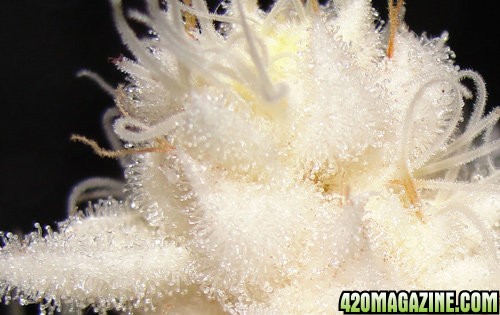I love to discuss "sciency" topics. I get that it would "appear" the bleached buds are not producing energy as efficiently as other parts of the plant that have or are more chlorophyll. However that is an assumption and not based on science.
Here's another question: How do white caladiums live... they perform photosynthesis just like any other green plant but all the leaves are white! What happens with them is they "appear" to be white but perform photosynthesis perfectly well.
Some plants have little or no chlorophyll in the non-green areas, but many others have changed the architecture of their leaf cell layers in the non-green areas,, creating refraction effects that make the leaves appear white, but don't significantly change their photosynthetic efficiency (Sheue et al.) In fact, Arum italicum white areas actually have higher efficiency in certain light conditions! (La Rocca et al.)
link to abstract: Variegation in Arum italicum leaves. A structural–functional study
So getting back to the question at hand. There are plenty of examples in nature and in the greenhouse where white parts of green plants actually perform photosynthesis as good or better than their green cousins. Many of which have been manipulated by humans.
There's this pesky little thing I keep stumbling on called the "scientific method" - Blow a hole in a hypothesis and that is all that is required to send us back to the drawing board and come up with a new hypothesis. Then test ... and on it goes.
I submit that the white tips of the buds are indeed performing photosynthesis and could even be MORE efficiently performing this function. I do not have the facts to back that up, only an unanswered question and observations of other plants that have been tested to perform well even when they seem to have little or no chlorophyll.
There is this fact... the bud tips that are white are healthy and living.
Here's another question: How do white caladiums live... they perform photosynthesis just like any other green plant but all the leaves are white! What happens with them is they "appear" to be white but perform photosynthesis perfectly well.
Some plants have little or no chlorophyll in the non-green areas, but many others have changed the architecture of their leaf cell layers in the non-green areas,, creating refraction effects that make the leaves appear white, but don't significantly change their photosynthetic efficiency (Sheue et al.) In fact, Arum italicum white areas actually have higher efficiency in certain light conditions! (La Rocca et al.)
link to abstract: Variegation in Arum italicum leaves. A structural–functional study
So getting back to the question at hand. There are plenty of examples in nature and in the greenhouse where white parts of green plants actually perform photosynthesis as good or better than their green cousins. Many of which have been manipulated by humans.
There's this pesky little thing I keep stumbling on called the "scientific method" - Blow a hole in a hypothesis and that is all that is required to send us back to the drawing board and come up with a new hypothesis. Then test ... and on it goes.
I submit that the white tips of the buds are indeed performing photosynthesis and could even be MORE efficiently performing this function. I do not have the facts to back that up, only an unanswered question and observations of other plants that have been tested to perform well even when they seem to have little or no chlorophyll.
There is this fact... the bud tips that are white are healthy and living.








 Doc where ever you are.
Doc where ever you are.